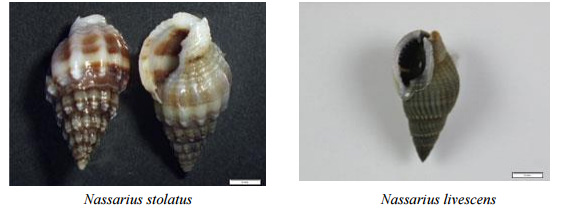Species Diversity and Spatial Distribution of Macroinvertebrates on the Intertidal Zone of Rajamangala Beach, Trang Province, Thailand
Main Article Content
Abstract
The study on species diversity and spatial distribution of macro-invertebrates on the intertidal zone of Rajamangala beach, Trang province, Thailand aims to investigate species, numbers and spatial distribution changes of polychaetes, mollusks and crabs along the 2 km beach. Four sampling stations from an adjacent of the estuary to the end at the beach, located near a hill, were examined. Each station was divided into four lines: highest tide, 100 m, 200 m and 300 m in distance from the high tide line. Quadrate sampling method was applied for sample collection in monsoon and dry seasons with three replicates in a season. The results showed that 23 polychaete, 23 mollusk and 19 crab species were found. The highest polychaete diversity was recorded at the lowest tide line. At 200 m and 300 m from the highest tide line, there was the highest diversity of mollusk species, whereas at 100 m from the highest tide line, the diversity of crab species was highest. Lumbrineris punctata McIntosh, 1885 and Scoloplos spp. were dominated polychaete species of the 200 m and 300 m whereas Glycera spp. were frequently found at the 100 m from the highest tide line. For mollusk species, high densities of Nassarius spp., Pilucina sp. and Donax incarnatus Gmelin, 1791 were found. Crab species found on the beach were in Infraorder Brachyura (15 species) and Anomura (four species). The most abundant species was Dotilla myctiroides (Milne-Edwards, 1852) followed by Scopimera proxima Kemp, 1919. The species diversity of all sampling stations had similar distribution, but from the highest tide line to the lowest tide line, a different pattern of macroinvertebrate species distribution was found.
Article Details
Published articles are under the copyright of the Environment and Natural Resources Journal effective when the article is accepted for publication thus granting Environment and Natural Resources Journal all rights for the work so that both parties may be protected from the consequences of unauthorized use. Partially or totally publication of an article elsewhere is possible only after the consent from the editors.

